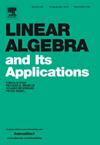Matrix invertible extensions over commutative rings. Part II: Determinant liftability
IF 1.1
3区 数学
Q1 MATHEMATICS
引用次数: 0
Abstract
A unimodular matrix A with entries in a commutative ring R is called weakly determinant liftable if there exists a matrix B congruent to A modulo and ; if we can choose B to be unimodular, then A is called determinant liftable. If A is extendable to an invertible matrix , then A is weakly determinant liftable. If A is simply extendable (i.e., we can choose such that its entry is 0), then A is determinant liftable. We present necessary and/or sufficient criteria for A to be (weakly) determinant liftable and we use them to show that if R is a ring in the sense of Part I (resp. is a pre-Schreier domain), then A is simply extendable (resp. extendable) iff it is determinant liftable (resp. weakly determinant liftable). As an application we show that each domain (as defined by Lorenzini) is an elementary divisor domain.
交换环上的矩阵可逆扩展。第二部分:行列式可提性
如果存在一个矩阵B同于A模Rdet (A)且det (B)=0,则具有交换环R中元素的幺模2×2矩阵A称为弱行列式可举;如果我们可以选择B是非模的,那么A就是行列式可举的。如果A可展成可逆3×3矩阵A+,则A是弱行列式可举的。如果A是简单可扩展的(即,我们可以选择A+使得它的(3,3)项为0),那么A是行列式可提升的。我们给出了A是(弱)行列式可举的必要和/或充分判据,并用它们来证明如果R是第1部分意义上的Π2环(见第2章)。是pre-Schreier域),那么a是简单可扩展的(例如。可扩展的)如果它是行列式可举的(如。弱行列式可举)。作为一个应用,我们证明了每个j2.1域(由Lorenzini定义)是一个初等除数域。
本文章由计算机程序翻译,如有差异,请以英文原文为准。
求助全文
约1分钟内获得全文
求助全文
来源期刊
CiteScore
2.20
自引率
9.10%
发文量
333
审稿时长
13.8 months
期刊介绍:
Linear Algebra and its Applications publishes articles that contribute new information or new insights to matrix theory and finite dimensional linear algebra in their algebraic, arithmetic, combinatorial, geometric, or numerical aspects. It also publishes articles that give significant applications of matrix theory or linear algebra to other branches of mathematics and to other sciences. Articles that provide new information or perspectives on the historical development of matrix theory and linear algebra are also welcome. Expository articles which can serve as an introduction to a subject for workers in related areas and which bring one to the frontiers of research are encouraged. Reviews of books are published occasionally as are conference reports that provide an historical record of major meetings on matrix theory and linear algebra.

 求助内容:
求助内容: 应助结果提醒方式:
应助结果提醒方式:


